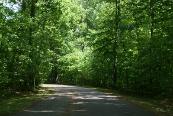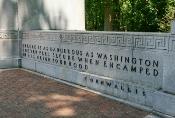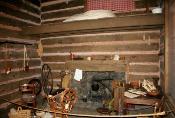

ExploreSouthernHistory.com - Guilford Courthouse NMP, North Carolina
ExploreSouthernHistory.com - Guilford Courthouse NMP, North Carolina

| Greene Monument at Guilford Courthouse A magnificent monument of General Nathaniel Greene looks out over the battlefield where he achieved a remarkable victory through defeat. |
The Battle Begins
The British launched their
attack from the Hoskins Farm,
now preserved at the adjacent
Colonial Heritage Center.
The British launched their
attack from the Hoskins Farm,
now preserved at the adjacent
Colonial Heritage Center.

Greene's Second Line
A paved trail leads through
the woods at the site of the
sustained firefight offered by
the American second line.
A paved trail leads through
the woods at the site of the
sustained firefight offered by
the American second line.


Site of Guilford Courthouse
Nothing remains of the
original Guilford Courthouse,
where Greene anchored his
third and final line.
Nothing remains of the
original Guilford Courthouse,
where Greene anchored his
third and final line.
Guilford Courthouse National Military Park - North Carolina
Battle of Guilford Courthouse

Woods on the Battlefield
The battle was a swirling,
confused affair, much of
which was fought in heavy
woods like these.
The battle was a swirling,
confused affair, much of
which was fought in heavy
woods like these.
| Copyright 2011 by Dale Cox All rights reserved. |
On March 15, 1781, American and British
armies fought the pivotal Battle of Guilford
Courthouse in the woods and fields of North
Carolina.
A key moment of the American Revolution,
Guilford Courthouse took its name from a
small country courthouse around which
Patriot general Nathaniel Greene formed his
third line of defense. The site is now a
national military park in Greensboro, North
Carolina.
The Battle of Guilford Courthouse was the
climactic moment of a campaign waged
across North and South Carolina and into
Virginia in January through March of 1781.
Greene had employed the dangerous
strategy of dividing his army in the face of the
much larger army of Lord Charles, Earl
Cornwallis.
One wing of Greene's army, led by General
Daniel Morgan, smashed a portion of
Cornwallis' army at the Battle of Cowpens in
South Carolina, igniting a movement
remembered as the "Race to the Dan." With
Cornwallis hot on his heels, Greene waged a
fighting retreat across North Carolina to
safety behind the natural barrier of the Dan
River in Virginia.
General Greene crossed the Dan River to
safety on February 14, 1781. Over the days
that followed he received strong militia
reinforcements from Virginia. For the next
three weeks the two potent armies warily
watched each other. Then, on March 15th,
Greene seized the initiative. Forming his men
in a strong position at Guilford Courthouse,
he welcomed an attack by Cornwallis.
The Battle of Guilford Courthouse was fought
on the same tactical plan as Morgan's
inspired victory at Cowpens. A loose
adaptation of the two battles, in fact, forms
the basis for the climactic fight in the Mel
Gibson movie, The Patriot.
Taking advantage of fence rows facing open
fields, woods, and low rises in the ground,
Greene formed his men in three more or
less parallel lines. The first of these, one-half
mile wide, was held by North Carolina militia
and Delaware regulars. Positioned behind a
zig-zag rail fence with a clear field of fire
before them, the men were supported by
veteran cavalry companies on the flanks and
two 6-pounder cannon positioned in the
center so as to fire down the historic Great
Salisbury Wagon Road.
Behind this front line, the Americans formed
a second line held by Virginia militia. This
position was in the woods, which were
expect to break up the formation of the British
troops as they advanced.
Another 500 yards back and around the little
wooden Guilford Courthouse, Greene formed
his final line of seasoned Virginia and North
Carolina Continental regulars. They were
placed in a "V" shaped formation with two
cannon in the center.
The plan was for the first line to fall back
when pressed, pulling the British into the
muskets of the second and eventually third
lines. It was a tactical arrangement that had
worked with devastating effect at Cowpens in
January. It would work again at Guilford
Courthouse.
Advancing up the road directly at the Patriot
positions, Cornwallis formed his army on the
farm of Joseph Hoskins, who had fled an
earlier home in Pennsylvania because of
Revolutionary War action there. The site is
now preserved as Tannenbaum Park and the
Colonial Heritage Center.
The battle began with a ferocious exchange
of cannon fire and then the British stepped
off, to the sound of drums and bagpipes, and
began their march across the open fields at
the American first line.
Greene's militia opened fire when the British
were 150 yards out. The storm of lead cut
down the advancing soldiers in lines, but
they kept coming. As they closed into effective
range, the British halted, delivered a well-
timed volley of their own, and then went at the
Americans with a loud "huzza" and a bayonet
charge.
Panic rippled through the men on Greene's
first line and they began to scatter. Some
retreating wildly through the woods, others
linking up with more seasoned men under
Light-Horse Harry Lee and William
Campbell. The latter group withdrew off to the
southeast, pulling away two of the British
regiments with them, and continuing a
separate fight that actually lasted longer than
the main battle.
armies fought the pivotal Battle of Guilford
Courthouse in the woods and fields of North
Carolina.
A key moment of the American Revolution,
Guilford Courthouse took its name from a
small country courthouse around which
Patriot general Nathaniel Greene formed his
third line of defense. The site is now a
national military park in Greensboro, North
Carolina.
The Battle of Guilford Courthouse was the
climactic moment of a campaign waged
across North and South Carolina and into
Virginia in January through March of 1781.
Greene had employed the dangerous
strategy of dividing his army in the face of the
much larger army of Lord Charles, Earl
Cornwallis.
One wing of Greene's army, led by General
Daniel Morgan, smashed a portion of
Cornwallis' army at the Battle of Cowpens in
South Carolina, igniting a movement
remembered as the "Race to the Dan." With
Cornwallis hot on his heels, Greene waged a
fighting retreat across North Carolina to
safety behind the natural barrier of the Dan
River in Virginia.
General Greene crossed the Dan River to
safety on February 14, 1781. Over the days
that followed he received strong militia
reinforcements from Virginia. For the next
three weeks the two potent armies warily
watched each other. Then, on March 15th,
Greene seized the initiative. Forming his men
in a strong position at Guilford Courthouse,
he welcomed an attack by Cornwallis.
The Battle of Guilford Courthouse was fought
on the same tactical plan as Morgan's
inspired victory at Cowpens. A loose
adaptation of the two battles, in fact, forms
the basis for the climactic fight in the Mel
Gibson movie, The Patriot.
Taking advantage of fence rows facing open
fields, woods, and low rises in the ground,
Greene formed his men in three more or
less parallel lines. The first of these, one-half
mile wide, was held by North Carolina militia
and Delaware regulars. Positioned behind a
zig-zag rail fence with a clear field of fire
before them, the men were supported by
veteran cavalry companies on the flanks and
two 6-pounder cannon positioned in the
center so as to fire down the historic Great
Salisbury Wagon Road.
Behind this front line, the Americans formed
a second line held by Virginia militia. This
position was in the woods, which were
expect to break up the formation of the British
troops as they advanced.
Another 500 yards back and around the little
wooden Guilford Courthouse, Greene formed
his final line of seasoned Virginia and North
Carolina Continental regulars. They were
placed in a "V" shaped formation with two
cannon in the center.
The plan was for the first line to fall back
when pressed, pulling the British into the
muskets of the second and eventually third
lines. It was a tactical arrangement that had
worked with devastating effect at Cowpens in
January. It would work again at Guilford
Courthouse.
Advancing up the road directly at the Patriot
positions, Cornwallis formed his army on the
farm of Joseph Hoskins, who had fled an
earlier home in Pennsylvania because of
Revolutionary War action there. The site is
now preserved as Tannenbaum Park and the
Colonial Heritage Center.
The battle began with a ferocious exchange
of cannon fire and then the British stepped
off, to the sound of drums and bagpipes, and
began their march across the open fields at
the American first line.
Greene's militia opened fire when the British
were 150 yards out. The storm of lead cut
down the advancing soldiers in lines, but
they kept coming. As they closed into effective
range, the British halted, delivered a well-
timed volley of their own, and then went at the
Americans with a loud "huzza" and a bayonet
charge.
Panic rippled through the men on Greene's
first line and they began to scatter. Some
retreating wildly through the woods, others
linking up with more seasoned men under
Light-Horse Harry Lee and William
Campbell. The latter group withdrew off to the
southeast, pulling away two of the British
regiments with them, and continuing a
separate fight that actually lasted longer than
the main battle.

American Revolution in the South
Battle of Fort Charlotte - Alabama
Battle of Arkansas Post - Arkansas
Battle of Pensacola - Florida
Fort George Historic Site - Florida
Battle of Cowpens - South Carolina
Battle of Kings Mountain - South Carolina
Ninety Six National Historic Site - South Carolina
Alamance Battleground - North Carolina
Battle of Yorktown - Virginia
Battle of Fort Charlotte - Alabama
Battle of Arkansas Post - Arkansas
Battle of Pensacola - Florida
Fort George Historic Site - Florida
Battle of Cowpens - South Carolina
Battle of Kings Mountain - South Carolina
Ninety Six National Historic Site - South Carolina
Alamance Battleground - North Carolina
Battle of Yorktown - Virginia

Custom Search



The main British advance continued into the
woods, which served to break up their
formations just as Greene had expected. A
severe firefight erupted as they approached
the American second line. The battle became
intense and confusing. The heavy woods
prevented the British from using their
bayonets to advantage and the bloodshed
was frightful.
The Redcoats finally broke through the
American second line and surged forward to
Greene's third and strongest position. The
lines there surged back and forth. Greene
ordered his cavalry into the fight and the
British found themselves attacked from both
front and flanks.
Facing the realization that his army was
about to collapse, Cornwallis ordered his
artillery to open fire on the swirling mass of
men, striking down friend and foe alike. The
desperate move worked and the American
attacks were halted.
Additional British units poured in from all
parts of the field and the tide of the battle
began to turn. Realizing he had done all he
could reasonably expect, Greene ordered his
men to withdraw. The move, according to
American reports, was carried out "leisurely."
Cornwallis won the Battle of Guilford
Courthouse, but at a frightful cost. The British
suffered a loss of around 93 killed and 413
wounded, compared to an American loss of
roughly 79 killed and 260 wounded. Many of
the wounded from both sides died in the
following days and weeks.
The American army retreated intact and
encouraged, having gone toe to toe with
some of the finest British troops in the field
for hours. For the British, however, the story
was different. Cornwallis had left behind or
destroyed most of his supplies for the sake
of speed during the "Race to the Dan" and
now his army was forced to raid and pillage
for provisions.
With no other option, within a few weeks he
was forced to turn back to the coast. He
moved down and occupied Wilmington, a
withdrawal that put him on the road to the
Battle of Yorktown and his surrender to
George Washington. Greene, meanwhile,
turned south and soon reasserted American
control over most of the Carolinas and
Georgia.
The Battle of Guilford Courthouse clearly
demonstrated his maxim of fight, get beat,
fight again that so bled the British forces in
the South.
Guilford Courthouse National Military Park is
located at 2332 New Garden Road in
Greensboro, North Carolina. The park is
open daily from 8:30 a.m. to 5 p.m. There is
no cost to visit. Please click here for more
information.
While visiting the park, be sure to stop in first
at the adjacent Colonial Heritage Center at
Tannenbaum Historic Park. Located on New
Garden Road just before you reach the
battlefield, it offers outstanding displays, a
scale model of the entire battle and the farm
where Cornwallis formed his troops. Please
click here for more information.
woods, which served to break up their
formations just as Greene had expected. A
severe firefight erupted as they approached
the American second line. The battle became
intense and confusing. The heavy woods
prevented the British from using their
bayonets to advantage and the bloodshed
was frightful.
The Redcoats finally broke through the
American second line and surged forward to
Greene's third and strongest position. The
lines there surged back and forth. Greene
ordered his cavalry into the fight and the
British found themselves attacked from both
front and flanks.
Facing the realization that his army was
about to collapse, Cornwallis ordered his
artillery to open fire on the swirling mass of
men, striking down friend and foe alike. The
desperate move worked and the American
attacks were halted.
Additional British units poured in from all
parts of the field and the tide of the battle
began to turn. Realizing he had done all he
could reasonably expect, Greene ordered his
men to withdraw. The move, according to
American reports, was carried out "leisurely."
Cornwallis won the Battle of Guilford
Courthouse, but at a frightful cost. The British
suffered a loss of around 93 killed and 413
wounded, compared to an American loss of
roughly 79 killed and 260 wounded. Many of
the wounded from both sides died in the
following days and weeks.
The American army retreated intact and
encouraged, having gone toe to toe with
some of the finest British troops in the field
for hours. For the British, however, the story
was different. Cornwallis had left behind or
destroyed most of his supplies for the sake
of speed during the "Race to the Dan" and
now his army was forced to raid and pillage
for provisions.
With no other option, within a few weeks he
was forced to turn back to the coast. He
moved down and occupied Wilmington, a
withdrawal that put him on the road to the
Battle of Yorktown and his surrender to
George Washington. Greene, meanwhile,
turned south and soon reasserted American
control over most of the Carolinas and
Georgia.
The Battle of Guilford Courthouse clearly
demonstrated his maxim of fight, get beat,
fight again that so bled the British forces in
the South.
Guilford Courthouse National Military Park is
located at 2332 New Garden Road in
Greensboro, North Carolina. The park is
open daily from 8:30 a.m. to 5 p.m. There is
no cost to visit. Please click here for more
information.
While visiting the park, be sure to stop in first
at the adjacent Colonial Heritage Center at
Tannenbaum Historic Park. Located on New
Garden Road just before you reach the
battlefield, it offers outstanding displays, a
scale model of the entire battle and the farm
where Cornwallis formed his troops. Please
click here for more information.
Colonial Heritage Center
Tannenbaum Park
Battle of Guilford Courthouse
Battle of Kings Mountain
Battle of Cowpens
Crossing the Dan
Historic Sites in North Carolina
Explore other Southern Historic Sites
Tannenbaum Park
Battle of Guilford Courthouse
Battle of Kings Mountain
Battle of Cowpens
Crossing the Dan
Historic Sites in North Carolina
Explore other Southern Historic Sites


Battlefield Tour Road
Guilford Courthouse can be
toured by either car or on foot.
The tour road passes parking
spots with interpretive panels
and views of the battlefield.
Guilford Courthouse can be
toured by either car or on foot.
The tour road passes parking
spots with interpretive panels
and views of the battlefield.


Tribute from an Enemy
The famous quote from Gen.
Cornwallis, "Greene is as
dangerous as Washington,"
is inscribed on the Greene
Monument.
The famous quote from Gen.
Cornwallis, "Greene is as
dangerous as Washington,"
is inscribed on the Greene
Monument.


Colonial Heritage Center
Located adjacent to the
national park area, Colonial
Heritage Center offers a wide
array of exhibits about the
battle and colonial life in
North Carolina.
Located adjacent to the
national park area, Colonial
Heritage Center offers a wide
array of exhibits about the
battle and colonial life in
North Carolina.

